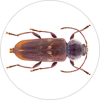Wood weeds: woodworms and termites
The control of wood pests and the conservation of cultural heritage is a topic to be addressed correctly with a series of multidisciplinary skills possessed by professionals in the various specializations (entomology experts for monitoring, which must also concern thermo / hygrometric aspects, restorers and exterminators) such as those selected by the Ecopiakos company for their ability, seriousness and reliability. The main ones are woodworms and termites (there are mainly only two species present here, in the central south and islands). The woodworms that attack the wood in work (carpentry, boiserie and furniture) in Italy they are basically divided into 3 large groups:
- Anobidae (more frequent but less harmful to wood)
- Lictidae
- Cerambicides (rarer but more harmful to wood in operation) of massive infestations, they can also sting people. In this case, therefore, it is advisable to provide in addition to the protection of the wood, also the disinfestation against these parasites.
Termites
Fighting an infestation from woodworms and termites
A definitely green method is to focus on prevention. Try not to have leaking pipes and avoid water stagnation, especially if near the foundations and in contact with the ground: they could attract termites outside or inside the house. Then you have to seal windows, doors and cracks. Another important step for prevention is to keep firewood, logs and branches away from home.First of all we need to understand if these insects have already settled in our home, leaving around in points such as cellars, attics and in the cavities of cardboard soaked in water and stacked on top of each other. Termites love cellulose and are very fond of it: if these 'baits' are filled with pets, the signal is clear. Burn them in a safe place and repeat the operation several times to understand where they come from.But this is only a very mild and temporary do-it-yourself remedy: if you want to solve the root problem, it is absolutely mandatory to contact companies specialists in the sector like ours. Surely one of the solving methods is heat treatment.
Exterra solution
The Exterra System is a modular and patented procedure for monitoring and controlling underground termites (Reticulitermes lucifugus), it is applied by our network of qualified and authorized technicians for the installation of the plants. Exterra ™ represents a solution for the control of termites, effective and respectful for the environment. It is able to control infestations through the total destruction of underground termite nests, offering lasting protection and preventive action.Its implementation represents a complex operation, The basic concept is represented by bait food baiting natural wood, monitored periodically; the insecticide product is used only in the final control phase. The use of chemicals is therefore significantly reduced.









